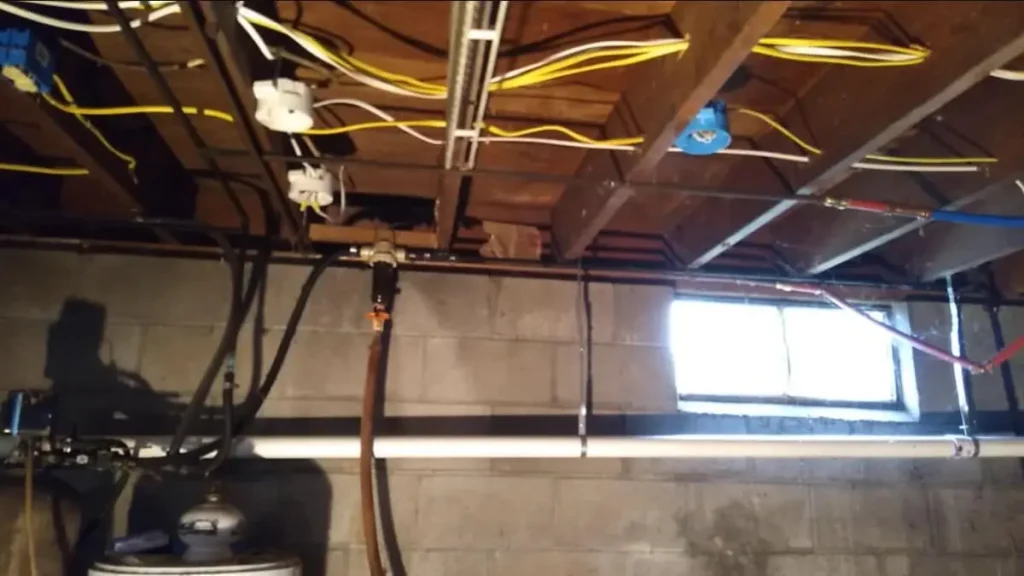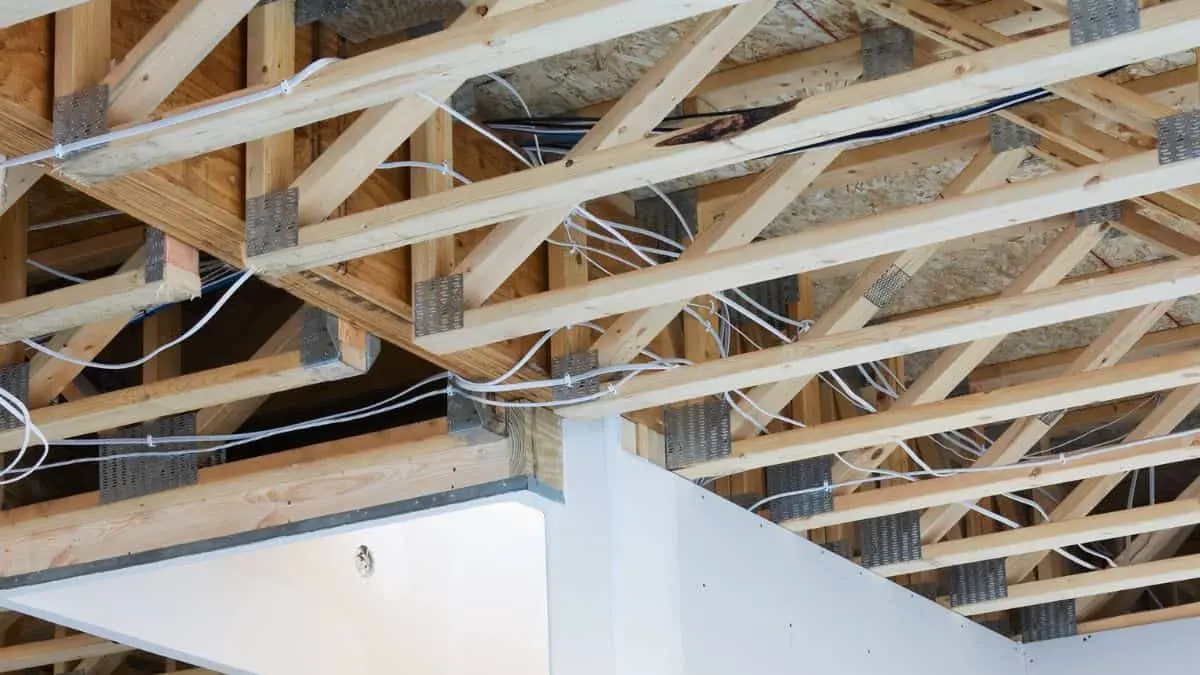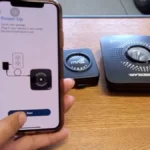Have you ever wondered about the secrets behind the walls of your home? Specifically, about those essential wires that bring life to your lights, appliances, and gadgets?
Well, today, we’re diving into one such secret: running Romex through floor joists. It’s a task that might sound daunting, but with the right approach, it can be a rewarding DIY project.
First off, let’s talk about what Romex is. In the world of home wiring, Romex is a hero. It’s a type of electrical cable that’s become a household name in the United States. Known for its simplicity and durability, it’s often the go-to choice for residential wiring. But the real magic happens when it’s run through floor joists – those horizontal supports that make up part of your floor’s framework.
You might be a seasoned DIY enthusiast or someone just stepping into the realm of home remodeling. Either way, this guide is for you. We’re going to walk through the process of running Romex through floor joists, step by step. It’s not just about threading a cable through some holes. This task is an art that blends precision, safety, and a bit of patience.
Remember the time you first rode a bike? There was a mix of excitement and nerves, right? That’s a bit like running Romex for the first time. But don’t worry, I’m here to guide you through it, just like a knowledgeable friend would. So, grab your tools (and a coffee!), and let’s get started on this electrifying journey!
What You Need to Know About Romex Wiring
What is Romex Wire?
Romex is a brand name for non-metallic (NM) sheathed electrical cable, widely used in residential wiring. Manufactured by Southwire, Romex cables consist of multiple conductors enclosed within a thermoplastic sheath, which provides insulation and protection. This cable is primarily used for indoor applications in dry locations, such as running electrical wiring through walls, ceilings, and floor joists.
A typical Romex cable contains:
- Hot wire(s) (black or red): Carries electrical current from the breaker panel to the device.
- Neutral wire (white): Completes the circuit by returning current to the panel.
- Ground wire (bare copper or green): Provides a safe path for electricity in case of a fault.
Romex wiring is not rated for outdoor or wet locations, as its non-metallic sheath does not offer significant protection against moisture, extreme temperatures, or physical damage. Instead, conduit wiring or UF-B (Underground Feeder) cable should be used for outdoor installations.
What Are the Different Types of Romex?
Romex comes in various types, each suited for specific electrical applications. The main differences between them lie in the number of conductors, wire gauge, and insulation rating. Below are the most common types:
- Romex NM-B (Non-Metallic, Type B):
- The most common type used for indoor residential wiring.
- Rated for dry locations only (walls, ceilings, floor joists, etc.).
- Typically available in 14/2, 12/2, and 10/2 gauge sizes (the first number refers to conductor size, and the second to the number of insulated conductors).
- Temperature rating: 90°C (194°F).
- Common applications: General lighting, receptacles, and small appliances.
- Romex NM-C (Non-Metallic, Type C):
- A less common variation, designed for higher temperature resistance than NM-B.
- Used in some commercial or high-demand residential settings.
- Romex UF-B (Underground Feeder, Type B):
- Rated for direct burial underground without requiring conduit.
- Water-resistant and can withstand exposure to moisture, dirt, and sunlight.
- Typically used for outdoor wiring, such as running power to detached garages, sheds, or landscape lighting.
- Sheath is tougher than standard NM-B to withstand underground conditions.
- Romex 14/2, 12/2, 10/2, and 12/3 Wiring:
- 14/2 NM-B: 14-gauge wire, two conductors + ground, rated for 15-amp circuits.
- 12/2 NM-B: 12-gauge wire, two conductors + ground, rated for 20-amp circuits (commonly used for kitchen and bathroom outlets).
- 10/2 NM-B: 10-gauge wire, two conductors + ground, rated for 30-amp circuits (used for appliances like water heaters or air conditioners).
- 12/3 NM-B: 12-gauge wire, three conductors + ground, often used for three-way switch wiring or split circuits.
Choosing the Right Romex for Your Project
Selecting the correct Romex type depends on your electrical project’s location, amperage requirements, and environmental conditions. If you’re running Romex through floor joists in a dry, indoor space, NM-B is your best choice. However, for damp or outdoor environments, UF-B is required.
Pre-Installation Considerations

Before we jump into the nitty-gritty of running Romex through floor joists, let’s pause and plan. Pre-installation planning is like reading the recipe before baking a cake. It’s essential to ensure everything goes smoothly and safely.
Can I Run Romex Wire Between Joists?
The first question you might ask is, “Can I actually run Romex wire between joists?” The answer is a resounding yes! Floor joists, those sturdy beams that support your floor, are perfect pathways for your Romex wiring. But it’s not just about threading the wire through. You need to consider the route, the length of wire needed, and how to do it safely. It’s like plotting a road trip; you need to know where you’re going and what you’ll encounter along the way.
Assessing Wiring Needs
Start by determining the length and type of Romex required for your project. It’s a bit like measuring how much yarn you’ll need for a knitting project. Too short, and you’ll run out before you finish; too long, and you’ll have unnecessary excess. Use a tape measure to estimate the length of cable needed, considering the path it will take through the joists.
Tools and Materials Checklist
Now, let’s talk about tools and materials. Just as a painter needs brushes and paint, you’ll need specific tools for running Romex. Here’s a quick checklist:
- Romex cable (of course!)
- Drill and drill bits (for making holes in the joists)
- Cable staples and hammer (to secure the cable)
- Wire strippers and screwdrivers (for working with junction boxes)
- Protective gear like gloves and safety glasses
Picture yourself as a chef gathering ingredients and utensils. Having everything within reach makes the process more efficient and enjoyable.
Pre-installation is all about setting the stage. With a clear plan, the right tools, and a bit of prep work, you’re setting yourself up for success. Remember, the better the preparation, the smoother the installation will go. Now that we’ve laid the groundwork, we’re ready to dive into the actual process of running Romex through those floor joists. Let’s get to it!
Read Also: How to Reinforce Floor Joists for Plumbing
Safety and Compliance
Alright, let’s talk about safety and compliance when running Romex through floor joists. This is like putting on your seatbelt before driving; it’s essential for a safe journey.
Safety Precautions
First and foremost, safety is king. Working with electricity is no small feat—it demands respect and caution. Before you start, make sure to turn off the power to the area you’re working on. It’s like unplugging your toaster before you clean it; a simple step that’s crucial for safety.
Wearing the right protective gear is also vital. Safety glasses will protect your eyes from debris, especially when drilling. Gloves are your hands’ best friends, keeping them safe from cuts and scrapes. And let’s not forget sturdy shoes to safeguard your feet. Think of these as your DIY armor.
Understanding Code Compliance
Next up is code compliance. This is about following the rules of the road in the electrical world. Building codes vary by location, but they’re there for a reason—to ensure that electrical work is safe and reliable. It’s like following a recipe to make sure your cake comes out just right. You might need to pull permits for your electrical work, so check with your local building department. It’s always better to be safe than sorry.
Building Regulations
Adhering to building regulations is crucial. These regulations dictate how and where you can run electrical wiring, including specifics like the size of the holes you drill in joists and how to protect wires. Ignoring these rules is like ignoring road signs on a highway—it can lead to accidents and failures.
Importance of Inspections and Professional Guidance
Lastly, don’t underestimate the value of inspections and professional guidance. Once your work is done, having an inspector check it can be a lifesaver. They can spot issues you might have missed. And if you’re ever in doubt, seek help from a professional electrician. It’s like asking a teacher for help; they can provide guidance based on their experience and expertise.
Running Romex Through Floor Joists – Step-by-Step Guide

Now, we roll up our sleeves and get to the heart of the matter: running Romex through floor joists. Imagine this as a journey through a maze, where each step brings you closer to the finish line.
Step-1: Identifying Starting and Ending Points
First things first, pinpoint where your Romex cable will start and where it will end. This is like setting the start and finish lines of a race. You need to know where your electrical source is and where the cable needs to reach. Use a floor plan or a simple sketch to visualize the route. It’s a bit like planning a road trip; knowing your route makes the journey smoother.
Step-2: Drilling Holes Safely
Once you’ve mapped your route, it’s time to drill holes in the joists. This step requires precision and care. Use a drill with the appropriate size bit (usually about ¾ inch) to create passageways for your Romex cable. Remember, the holes should be centered in the joist and spaced according to code. It’s like threading a needle; accuracy is key.
Step-3: Protect and Secure the Romex Cable
Before running the cable, protect it with cable protectors or bushings at each hole. This step is like putting bumpers on a bowling alley lane; it keeps the cable safe from wear and tear. Then, gently feed your Romex cable through the first hole. It’s akin to guiding a thread through the eye of a needle – a gentle but firm hand is needed.
Step-4: Running the Cable Through the Holes
Now, guide the Romex cable through the drilled holes across the joists. It’s a bit like feeding a garden hose through a row of bushes. Take your time, and be careful not to damage the insulation. If you encounter resistance, don’t force it. Backtrack and check for any snags.
Step-5: Securing the Cable Properly
After running the cable, secure it with cable staples. Space these staples every few feet to keep the cable snug against the joists. This is similar to securing a vine along a trellis; it needs support to stay in place. But be careful not to staple too tightly, as it could damage the cable.
Step-6: Installing Protective Plates
Finally, where the cable runs close to the edge of a joist, protect it with a metal plate. These plates act as guards, preventing accidental punctures from nails or screws in the future. It’s like putting a shield around a delicate plant; it ensures the cable’s safety.
Electrical Box Installation
After running your Romex cable through the floor joists, the next step is installing electrical boxes. This is where your wires will connect to switches, outlets, or light fixtures. Think of these boxes as the docks in your electrical wiring harbor, where all connections safely reside.
Step-1. Types of Electrical Boxes
Firstly, let’s explore the types of electrical boxes available. You’ll find plastic and metal boxes, each suitable for different scenarios. Plastic boxes are commonly used in residential settings due to their ease of installation and insulation properties. Metal boxes are preferred in areas where additional grounding is required. It’s like choosing between a backpack and a suitcase; each serves a purpose depending on your journey.
Step-2. Placement of Boxes
Deciding on the placement of these boxes is crucial. It’s like placing the furniture in your house; location matters for both functionality and aesthetics. Generally, boxes are installed at a standard height from the floor, but this can vary based on your specific needs and local codes. Use a tape measure to mark the precise spot on the joist where each box will go.
Step-3. Securing the Boxes
Once you’ve marked the spots, secure the boxes to the joists. If you’re using nail-on boxes, it’s as straightforward as hammering them into place. Clamp-style boxes might require a screwdriver. Imagine you’re hanging a picture frame; it needs to be secure enough to hold the weight and stay in place.
Step-4. Box Fill Calculations
Box fill calculations are next, and they’re more important than they might sound. These calculations ensure that your box isn’t overcrowded with wires, which could lead to overheating or short circuits. It’s a bit like packing a suitcase; overstuff it, and you can’t close it properly. Your local electrical code will guide you on how many wires and connectors each box size can safely accommodate.
Step-5. Attaching Romex Wiring
Now, it’s time to attach the Romex wiring to the boxes. Strip the outer sheathing of the Romex to expose the individual wires, then connect them to the appropriate terminals inside the box. It’s similar to connecting the right cables to the back of your TV; each wire has its place.
Step-6. Cover Plates
Finally, once all the connections are made, attach cover plates to the boxes. This is not just for aesthetics; it’s a safety measure to protect the connections and prevent any accidental contact. It’s like putting a lid on a pot; it keeps everything safe and contained.
Best Practices and Tips
As we near the end of our journey in running Romex through floor joists, let’s pause and reflect on some best practices and tips. These nuggets of wisdom are like the secret ingredients in a family recipe, making your electrical project safer, more efficient, and more effective.
Plan Thoroughly
Before you even touch a tool, plan your project thoroughly. It’s like preparing for a road trip; knowing your route and stops makes for a smoother journey. Sketch out the path of the Romex, and double-check the lengths and types of cables needed. It’s always better to measure twice and cut once.
Use the Right Tools
Using the right tools is non-negotiable. Just like a chef uses specific knives for different cuts, you need to use the appropriate tools for drilling, cutting, and securing the Romex. Quality tools not only make the job easier but also prevent damage to your materials and your home.
Label Your Wiring
Imagine trying to find a specific photo in an album with no labels. That’s what dealing with unlabelled wiring is like. Label your cables at both ends. This simple step can save you hours of confusion and frustration, especially when making connections or troubleshooting in the future.
Avoid Overcrowding Boxes
Crowded electrical boxes are like overstuffed suitcases; they’re hard to manage and can be dangerous. Adhere to box fill calculations to prevent overheating and ensure easy access for future maintenance. Each wire needs its space to ensure safety and functionality.
Support the Cable
Running Romex is not just about laying a cable; it’s about securing it properly. Support the cable with staples or straps at regular intervals, ensuring it’s snug but not pinched. It’s akin to tying a boat to a dock; the support must be firm but not so tight that it damages the boat.
Respect Electrical Codes
Electrical codes are there for a reason, much like traffic laws. They ensure safety and efficiency. Familiarize yourself with local codes and standards, and adhere to them. It’s not just about passing inspections; it’s about ensuring the long-term safety of your home.
Double-Check Your Work
Finally, always double-check your work. Like a writer revising a manuscript, go over your wiring before calling it done. Ensure all connections are secure, staples are properly placed, and no wire is strained or pinched. This step is your final quality check, ensuring everything is as it should be.
Final Checks and Inspections
You’ve done the heavy lifting of running Romex through floor joists, and now it’s time for the final act – the checks and inspections. This stage is like the last lap of a marathon, where you ensure that all your hard work pays off safely and effectively.
Inspect Your Work for Compliance and Safety
Start by taking a thorough walkthrough of your work. Check each section of the Romex run to ensure it’s properly secured and protected. It’s like proofreading an important letter; you’re looking for any errors or omissions. Ensure that the cable is not pinched, twisted, or exposed to potential damage. This meticulous review is crucial for the safety and longevity of your electrical system.
Electrical Panel Check
Next, if your project involved making connections to the electrical panel, double-check these connections. They should be secure and properly labeled. This is akin to double-checking the locks on your doors before leaving home. Safety here is paramount, as improper connections can lead to serious hazards.
When to Seek Professional Help
If at any point during your final checks you feel unsure or spot something concerning, don’t hesitate to call in a professional electrician. This isn’t admitting defeat; it’s being smart and safe. Sometimes, getting a second opinion or professional verification can give you peace of mind. It’s like asking a mechanic to double-check your car’s brakes before a long journey.
Importance of Professional Inspections
In many cases, a professional inspection is required or highly recommended. An electrician or inspector can provide a comprehensive review of your work, ensuring that everything is up to code and safe. This step is not just a formality; it’s a crucial part of responsible home improvement. It’s like having a teacher review your test before submitting it; their expertise can catch things you might have missed.
Completing your final checks and inspections is a critical part of the electrical work process. It ensures that your efforts in running Romex through floor joists result in a safe, code-compliant, and efficient electrical system in your home. With this, you can rest easy knowing that your project is done correctly, safely, and professionally.
Troubleshooting Common Installation Challenges
Difficulty Feeding Cable Through Joists: If you’re struggling to feed the Romex through, check for obstructions or tight bends. Sometimes, using a fish tape can help guide the cable through tricky spots. It’s like using a map when you hit a roadblock on your route.
Damaged Cable Insulation: If you notice any nicks or cuts in the cable insulation, it’s essential to address this immediately. Damaged insulation can be a safety hazard. You might need to trim the damaged section and splice it, following proper electrical standards.
Cable Not Securing Properly: If staples or clips aren’t holding the cable snugly, double-check that you’re using the correct size and type for your Romex. It’s similar to choosing the right size nail for hanging a picture; the fit needs to be just right.
Frequently Asked Questions (FAQs)
How far apart should I space the cable staples?
Generally, staples should be placed every 30 inches along the run and within 8 inches of a box. Think of it like placing stepping stones in a garden; they need to be evenly spaced for a steady path.
Can I run Romex in parallel with plumbing pipes?
It’s best to avoid running electrical cables parallel and close to plumbing. The potential for moisture exposure and accidental damage is higher. Imagine cooking; you don’t want your water next to the electrical appliances.
What should I do if my drill bit isn’t long enough to reach through the joist?
In this case, you might need to drill from both sides of the joist. Ensure your holes align correctly by marking a guide on both sides. It’s like drilling a hole through a thick book; approach it from both covers to meet in the middle.
How do I know if my work is up to code?
The best way is to familiarize yourself with local building codes or consult a professional. It’s akin to following a recipe; you want to ensure you’re adding the right ingredients for a successful outcome.
When should I call a professional electrician?
If you’re ever in doubt about your ability to safely complete the project, it’s time to call in a professional. It’s like knowing when to visit a doctor instead of self-diagnosing; professional expertise is invaluable.
Remember, encountering challenges is a normal part of any DIY project. With patience and the right approach, you’ll navigate through them like a pro. If you have more questions, don’t hesitate to ask or seek professional advice. Up next, we’ll look into the final checks and inspections to ensure your project is not just complete, but also safe and up to code. Keep going; you’re almost there!
Conclusion
Congratulations! You’ve journeyed through the detailed process of running Romex through floor joists, a task that’s both intricate and immensely rewarding. From understanding the basics of Romex wiring to navigating the complexities of installation and compliance, you’ve tackled each step with the diligence of a true DIY enthusiast. It’s like completing a challenging puzzle; the satisfaction of seeing the final picture is incomparable.
Remember, the skills and knowledge you’ve gained through this project are invaluable. You’ve not only enhanced the safety and functionality of your home but also deepened your understanding of an essential aspect of home improvement. It’s like adding a new recipe to your cooking repertoire; you’ve gained a skill that will serve you for years to come.
As we wrap up, I encourage you to take a moment to reflect on your journey. Each obstacle you overcame and every problem you solved has contributed to your growth as a DIYer. And if you’ve decided to seek professional help along the way, remember that recognizing when to call in experts is a sign of wisdom and responsibility.
I hope this guide has been a helpful companion in your DIY journey. If you have stories, questions, or tips from your experience, feel free to share them. Let’s keep the conversation going and continue to support each other in our home improvement adventures.
Thank you for following along, and here’s to many more successful DIY projects in your future!
You May Also Read: Ductwork Between Floor Joists



